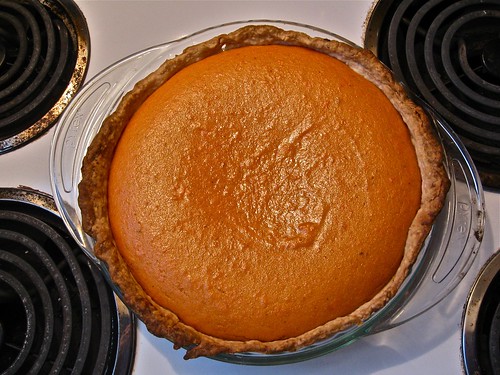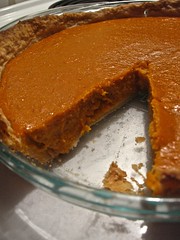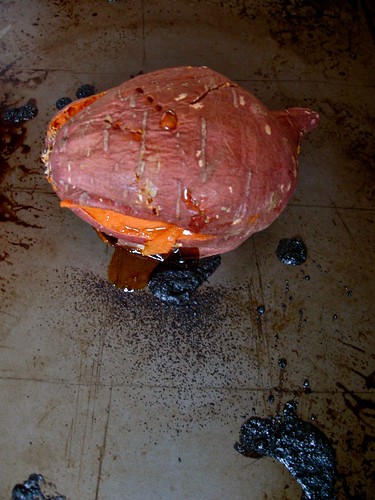After embracing the desire to make pie, my thoughts turned to Meyer lemons--how much I don't like them and how much I want to like them. I think the first time I had a Meyer lemon was the day I picked one off the unkempt lemon tree in our yard. It was a few months after I had moved to California and I was thrilled to have such an accessible fruit tree in my back yard. (Growing up, we had a crabapple tree behind the house. My brothers would use its bitter, unpalatable fruit as sibling ammunition. When fruit is used to create marble-sized bruises on the arms and legs of a sister sandwiched between an older and a younger brother, I, personally, don't think it should count.) I envisioned myself bathed in California sun, leisurely picking bursting bright yellow lemons off of a fruit-laden tree and freshening up my drinking water, meals, and cleaning agents with crisp homegrown citrus. I'd have a fruit bowl on the counter overflowing with them all year round. I'd be known in the neighborhood for my exquisite and thoughtful use of lemons.
I'm such a dreamer.
When I picked the fruit off the tree, I naturally expected a strong, solid, sour lemon. I was sorely disappointed. Instead, I discovered I'd just flavored my ice water with a flat half-lemon, half-orange hybrid that couldn't decide which side of the citrus spectrum it belonged on. I tried making it into a custard (another dessert I'd never attempted before) and the result was completely inedible and sat in little covered custard dishes in the back of the fridge for a full two weeks, dripping condensation. After a couple of days, they settled into layers of colloidal yellow liquid and water.
I swore Meyer lemons off.
I was thinking my pie ambitions of this past weekend could lead me back to the Meyer lemon, though, and prove true every single wonderful thing I'd ever heard about them since the failed custard experiment. (To be fair, custard needs a double-boiler, which I didn't have at the time but tried to replicate using a pot of boiling water and an ovenproof mixing bowl. Just like a hammer doesn't make a great substitute for a food processor, an ovenproof mixing bowl doesn't make a great double-boiler, either.) When I reached for a bag of coffee beans in the (lemonless) fruit bowl on the counter on Sunday morning and one of our CSA-delivered sweet potatoes gave out from under the bag and collapsed into a slippery mush, I knew there were other plans for my pie. There were four sweet potatoes left, not counting the one that had just smeared all over my bag of coffee, and they were surely close to meeting the same sad, uneaten fate as their moldy brother. A quick solution?
Pie.
I'd never tasted sweet potato pie before, but it had, from what I could tell, a great reputation. I found an intriguing recipe on epicurious.com that suggested roasting the potatoes starting in a cold oven and on lower heat for a longer period of time to generate more maltose. I love the intersection of chemistry and food, even though I have no idea what maltose is or why it's a good thing. The recipe also included rum, so, maltose and gradual chemical reactions aside, I knew it had to be a win.
I also found a basic pie crust recipe on Epicurious and improvised the hell out of it, adding sour cream and lemon zest just to see what would happen (and also because, in my opinion, it's not a recipe if it doesn't include sour cream). I used coconut milk in place of most of the cow's milk the filling recipe called for (although I wish I'd substituted it one-for-one)--a little trick I learned during my short stint as a vegan.
The results are really amazing. This is a delicious pie. It's smooth and, thanks to the coconut milk, deliciously rich, sweet, and full-bodied. The spices give it a punch while the rum helps the flavor linger a bit in your mouth. Not being a fan of flaky pie crusts, the sour cream version made for a more solid and present dough.
In short: Maltose-ify your sweet potatoes. Make this pie. Don't skimp on the rum. Thank me later.
SWEET! Potato Pie
Makes one 9-inch pie


Crust
Recipe adapted from epicurious.com
1 1/2 c all-purpose flour
2 tsp sugar
1/2 tsp salt
1/2 c (1 stick) unsalted butter, cut into 1/4-inch cubes
3 tbsp sour cream
2 tbsp grated lemon zest
1+ tbsp ice water
Whisk flour, sugar, and salt in medium bowl until blended. Add butter and, using your fingers, knead and rub in until the mixture resembles coarse meal. Using a fork, mix in sour cream and lemon zest. Add ice water and stir until mixture is evenly moistened (add more ice water if needed). Roll dough into a ball; flatten into disk. Wrap in plastic and chill at least 1 hour. Bring dough to room temperature before rolling out and placing in a floured, 9-inch pie pan.
Filling
Adapted from another recipe at epicurious.com
4-5 small sweet potatoes (about 1 1/4 pounds)
1/4 c (1/2 stick) unsalted butter
3/4 c sugar
1/2 c coconut milk
1/4 c whole milk (forget it--just use 3/4 c coconut milk and skip the cow's milk altogether!)
3 eggs
1 tsp vanilla
1/2 tsp cinnamon
1/4 tsp freshly grated nutmeg
1/4 tsp salt
1 tbsp dark rum (I kind of wish I had used more.)
1 tbsp all-purpose flour
Prick the sweet potatoes with a fork and place on a shallow baking pan in the middle of a cold oven. Turn the oven on to 325 degrees F and roast until very tender, about 1 1/4 hours. (The potatoes will appear to be oozing. I'm pretty sure the ooze is maltose.)

Gettin' its maltose on
Cool potatoes to room temperature.
Raise the oven temperature to 400 degrees F, and place a shallow baking pan on the bottom rack.
Scoop the flesh from potatoes into a large bowl and discard the skins. Mash the sweet potatoes with a fork until smooth. Melt the butter in a small saucepan over medium heat and stir in the sugar (the mixture will be grainy). Add the butter mixture to the sweet potatoes and mix. Using a whisk, beat in the milk(s) and the eggs until smooth. Whisk in the remaining ingredients. The filling will be liquidy.
Pour the filling into the pie shell.
Carefully transfer the pie to the heated shallow baking pan in the oven and bake until the filling is just set (about 40 minutes). Transfer the pie to a rack to cool.
---
What? You want to know more about sweet potatoes and maltose? Turns out it's a documented chemistry thing. Check out this blurb from an article titled "Formation of Maltose in Sweet Potatoes on Cooking," published in Industrial and Engineering Chemistry in 1923:
It is evident that the formation of maltose is of paramount importance in the production of delicious cooked sweet potatoes as we know them...H. C. Gore, in Industrial and Engineering Chemistry, 1923, 15 (9), pp 938–940 http://pubs.acs.org/doi/abs/10.1021/ie50165a031 (for a snippet of the article)
Since upon cooking sweet potatoes at least half, and frequently nearly all, of the starch present becomes converted into sugar, our concept of the sweet potato as a starchy food should be revised, since when consumed by man it really is saccharine rather than starchy.

No comments:
Post a Comment